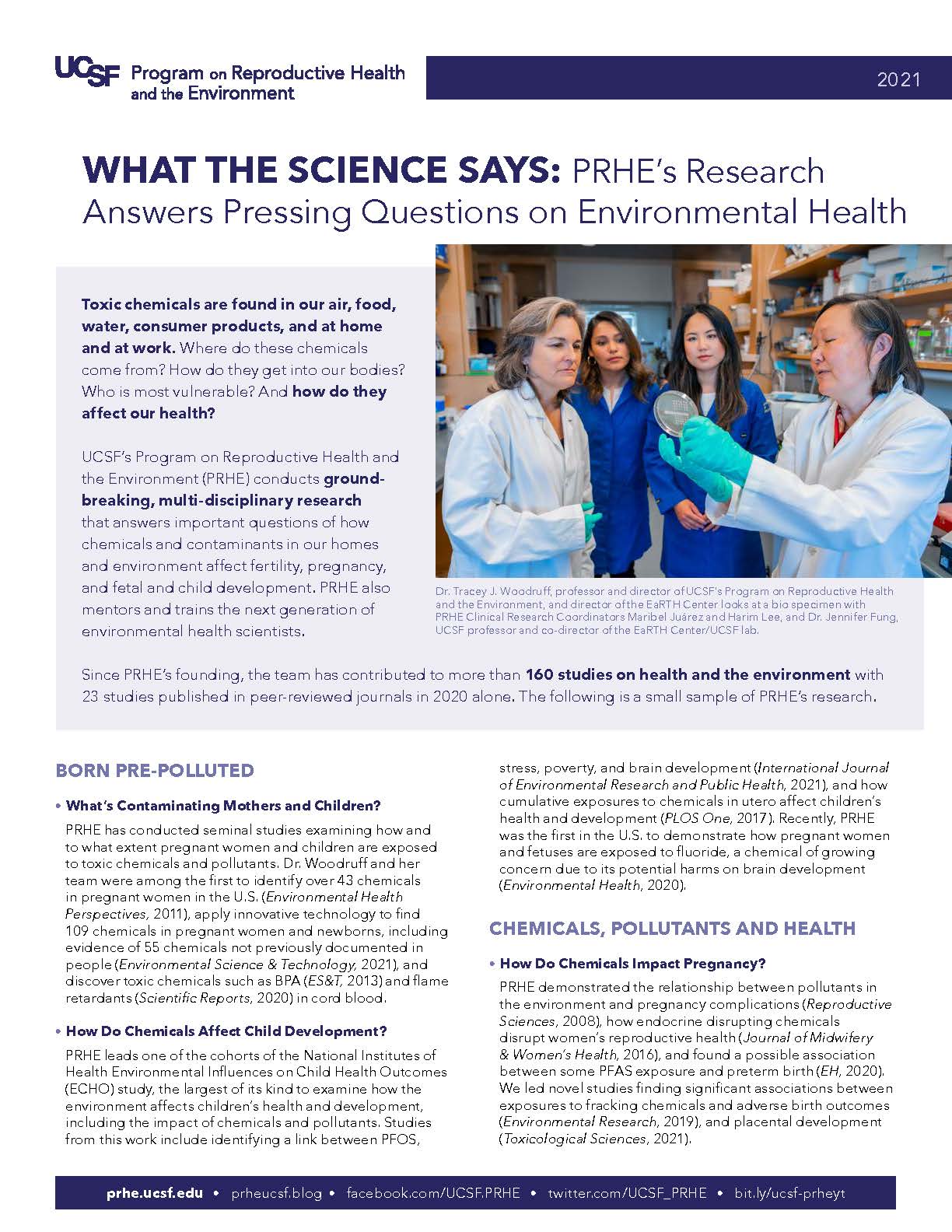Investigating environmental links to disease
Our ground-breaking, multidisciplinary research answers important questions on how chemicals and contaminants in our homes and environment affect fertility, pregnancy, fetal and child development, and health equity. We prioritize filling gaps in knowledge that support clinical decision-making and public policy.
We have written or contributed to more than 180 studies on health and the environment with 23 studies published in peer-reviewed journals in 2020 alone.
UCSF Study Finds Evidence of 55 Chemicals Never Before Reported in People
Scientists at UC San Francisco have detected 109 chemicals in a study of pregnant women, including 55 chemicals never before reported in people and 42 “mystery chemicals,” whose sources and uses are unknown. The chemicals most likely come from consumer products or other industrial sources.
The study was published March 17 in Environmental Science & Technology.
Major Research Areas

Chemicals
We study how harmful chemicals put into our air, food, water, homes, products, and workplaces affect pregnancy, child development, and health.

Plastics
Plastics are a petro-chemical product packed with endocrine-disrupting chemicals that can harm pregnancy, birth outcomes, neurodevelopment, and immune systems.

Climate and Wildfires
We examine how climate is impacting women's and children's health and how to protect pregnant people from wildfire smoke.
Key Research Projects

ECHO
The Environmental Influences on Child Health Outcomes (ECHO) is the largest NIH-funded study to date to explore how chemicals and pollutants in our environment impact pregnancy and child development.

DREAM
The Discovering cancer Risks from Environmental contaminants And Maternal/child health (DREAM) project collected data to explore how chemicals put in our air, food, and water increase cancer risk.

ENACT Center
In partnership with Stanford University, the Endometriosis Center for Action, Community Engagement and Training (ENACT) will work to improve endometriosis diagnosis and treatment by exploring the origins and environmental links to this disease.

PRHE conducts groundbreaking, multi-disciplinary research that answers important questions of how chemicals and contaminants in our homes and environment affect fertility, pregnancy, and fetal and child development. PRHE also mentors and trains the next generation of environmental health scientists.
Published Studies
Perfluoroalkyl and polyfluoroalkyl substances (PFASs) and organophosphate flame retardants (OPFRs) are chemicals that may contribute to placenta-mediated complications and adverse maternal-fetal health risks. Few studies have investigated these chemicals in relation to biomarkers of effect during pregnancy.
Restricting to live births can induce bias in studies of pregnancy and developmental outcomes, but whether this live-birth bias results in underestimating disparities is unknown. Bias may arise from collider stratification due to an unmeasured common cause of fetal loss and the outcome of interest, or depletion of susceptibles, where exposure differentially causes fetal loss among those with underlying susceptibility.
Genetic and environmental factors have been observed to influence risks for birth defects, though few studies have investigated gene–environment interactions. Our aim was to examine the interaction terms of gene variants in biotransformation enzyme pathways and air pollution exposures in relation to risk of several structural birth defects.
Infants whose mothers experience greater psychosocial stress and environmental chemical exposures during pregnancy may face greater rates of preterm birth, lower birth weight, and impaired neurodevelopment.
Preterm birth occurs at excessively high and disparate rates in the United States. In 2016, the National Institutes of Health (NIH) launched the Environmental influences on Child Health Outcomes (ECHO) program to investigate the influence of early life exposures on child health.
Telomere length in early life predicts later length, and shortened telomere length among adults and children has been linked to increased risk of chronic disease and mortality. Maternal stress during pregnancy may impact telomere length of the newborn.
Women can be exposed to a multitude of hardships before and during pregnancy that may affect fetal growth, but previous approaches have not analyzed them jointly as social exposure mixtures.

